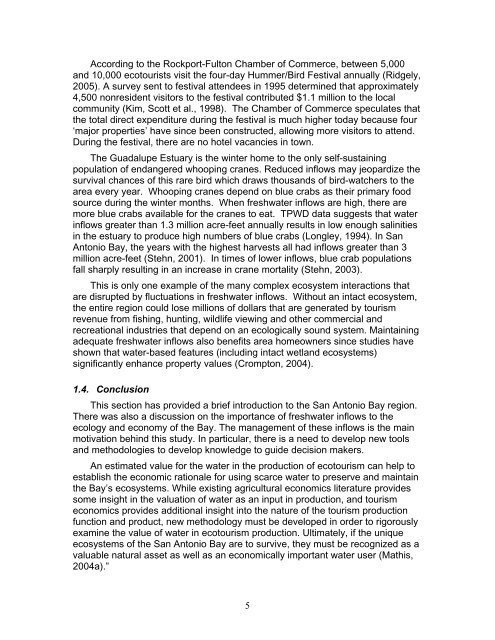The Economic Value of Water and Ecosystem Preservation
The Economic Value of Water and Ecosystem Preservation
The Economic Value of Water and Ecosystem Preservation
Create successful ePaper yourself
Turn your PDF publications into a flip-book with our unique Google optimized e-Paper software.
According to the Rockport-Fulton Chamber <strong>of</strong> Commerce, between 5,000<br />
<strong>and</strong> 10,000 ecotourists visit the four-day Hummer/Bird Festival annually (Ridgely,<br />
2005). A survey sent to festival attendees in 1995 determined that approximately<br />
4,500 nonresident visitors to the festival contributed $1.1 million to the local<br />
community (Kim, Scott et al., 1998). <strong>The</strong> Chamber <strong>of</strong> Commerce speculates that<br />
the total direct expenditure during the festival is much higher today because four<br />
‘major properties’ have since been constructed, allowing more visitors to attend.<br />
During the festival, there are no hotel vacancies in town.<br />
<strong>The</strong> Guadalupe Estuary is the winter home to the only self-sustaining<br />
population <strong>of</strong> endangered whooping cranes. Reduced inflows may jeopardize the<br />
survival chances <strong>of</strong> this rare bird which draws thous<strong>and</strong>s <strong>of</strong> bird-watchers to the<br />
area every year. Whooping cranes depend on blue crabs as their primary food<br />
source during the winter months. When freshwater inflows are high, there are<br />
more blue crabs available for the cranes to eat. TPWD data suggests that water<br />
inflows greater than 1.3 million acre-feet annually results in low enough salinities<br />
in the estuary to produce high numbers <strong>of</strong> blue crabs (Longley, 1994). In San<br />
Antonio Bay, the years with the highest harvests all had inflows greater than 3<br />
million acre-feet (Stehn, 2001). In times <strong>of</strong> lower inflows, blue crab populations<br />
fall sharply resulting in an increase in crane mortality (Stehn, 2003).<br />
This is only one example <strong>of</strong> the many complex ecosystem interactions that<br />
are disrupted by fluctuations in freshwater inflows. Without an intact ecosystem,<br />
the entire region could lose millions <strong>of</strong> dollars that are generated by tourism<br />
revenue from fishing, hunting, wildlife viewing <strong>and</strong> other commercial <strong>and</strong><br />
recreational industries that depend on an ecologically sound system. Maintaining<br />
adequate freshwater inflows also benefits area homeowners since studies have<br />
shown that water-based features (including intact wetl<strong>and</strong> ecosystems)<br />
significantly enhance property values (Crompton, 2004).<br />
1.4. Conclusion<br />
This section has provided a brief introduction to the San Antonio Bay region.<br />
<strong>The</strong>re was also a discussion on the importance <strong>of</strong> freshwater inflows to the<br />
ecology <strong>and</strong> economy <strong>of</strong> the Bay. <strong>The</strong> management <strong>of</strong> these inflows is the main<br />
motivation behind this study. In particular, there is a need to develop new tools<br />
<strong>and</strong> methodologies to develop knowledge to guide decision makers.<br />
An estimated value for the water in the production <strong>of</strong> ecotourism can help to<br />
establish the economic rationale for using scarce water to preserve <strong>and</strong> maintain<br />
the Bay’s ecosystems. While existing agricultural economics literature provides<br />
some insight in the valuation <strong>of</strong> water as an input in production, <strong>and</strong> tourism<br />
economics provides additional insight into the nature <strong>of</strong> the tourism production<br />
function <strong>and</strong> product, new methodology must be developed in order to rigorously<br />
examine the value <strong>of</strong> water in ecotourism production. Ultimately, if the unique<br />
ecosystems <strong>of</strong> the San Antonio Bay are to survive, they must be recognized as a<br />
valuable natural asset as well as an economically important water user (Mathis,<br />
2004a).”<br />
5
















